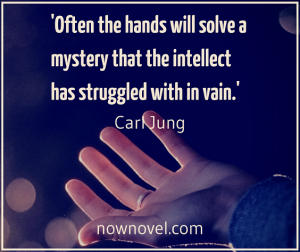What are essential components of mystery plots besides suspicion and secrets? What can Arthur Conan Doyle and cult classic TV mystery series teach us about writing better mysteries? Read 7 clues for writing your own engrossing puzzler:
How to write and develop mystery plots:
- Know different types of mysteries inside out
- Brainstorm your best mystery plot ideas
- Use core elements of gripping mystery plots
- Drop teasing clues like trails of crumbs
- Give characters strong motivations to find solutions
- Make story setting and atmosphere add mysterious effect
- Study top mystery writers - their work and advice
Let's think about each of these pointers:
1. Know different types of mysteries inside out
The definition of mystery ('secret, mystery, hidden meaning') comes from the French mistere. There are various mystery subgenres but in each, this idea of 'secrecy', of hidden truths brought to light, is the core principle.
In traditional murder mysteries, such Agatha Christie's famous Murder on the Orient Express (1934), the identity of the killer and their motive and connection to the victim is the secret driving revelation.
Detective novels and stories don't necessarily always involve murders, however. Sir Arthur Conan Doyle's The Adventures of Sherlock Holmes (1892) is a good example. Holmes solves mysteries including the location of a scandalous photograph (in 'A Scandal in Bohemia'), and the real identity of a suspicious fiance who disappears unexpectedly (in 'A Case of Identity').
The 'secret' in mystery fiction thus is often - but not always - crime-related. Mystery subgenres include:
- Traditional mysteries where the truth behind the mystery (e.g. a killer's identity) is typically concealed until near the end of the book
- Detective fiction - closely allied to mystery (with subgenres such as Hardboiled involving gritty, violent organised crime)
- Cozy mysteries that usually take place in small, intimate communities. Violence and sex are minimized
- Mystery-thrillers: Novels where there is special emphasis on suspense, excitement and action. These include legal thrillers, medical thrillers and 'police procedurals' (stories focusing on the details of police investigations)
Read widely across mystery's sub-genres and related genres. Each will give you lessons in creating the secrecy and revelation that is so addictive to mystery lovers.
2. Brainstorm your best mystery story ideas
Great mystery story ideas often include multiple levels of secrecy and revelation.
Take David Lynch's cult classic mystery TV series, Twin Peaks, for example. The series follows FBI agent Dale Cooper's investigation into the murder of Laura Palmer, a high school girl, in a town on the US/Canadian border. A synopsis of this mystery's central idea:
'In the small town of Twin Peaks a high school student is murdered. The FBI agent called in to investigate soon learns that everyone in Twin Peaks has a secret. There's also something strange about the woods surrounding the town...'
What makes Lynch's mystery idea so effective is that the identity of Laura's killer isn't the only mystery. Local property developer Benjamin Horne has cooked up a scheme to seize land for a new housing complex - will he be exposed? Diner waitress Shelley is cheating on her abusive boyfriend. Will he find out? Even the wood surrounding the town holds secrets.
Lynch and co-creator Mark Frost take the central idea of Laura's murder and layer on intrigues, giving many characters motives either for Laura's killing or for avoiding the FBI agent. Out of this central mystery story idea - the murder of an innocent-seeming teen - Lynch teases multiple smaller mysteries that throw the police (and the viewer) off the true murderer's trail.
When you brainstorm your next mystery novel idea, begin with a central mystery like Laura's killing. Brainstorm connections secondary characters have to the person or event at the heart of your mystery. In the case of a murder mystery, think about what secrets some characters would want to hide.

3. Use core elements of gripping mystery plots
Every genre has common plot elements that novels within the genre borrow. Fantasy has magic and/or alternate worlds. Romance has intimate relationships. Complete mystery plots typically include:
- Secret or hidden identities or motivations (for example, in Donna Tartt's The Secret History (1992) we know the killers' identities from the start but not their motivations for murder).
- Suspense: Almost every scene is loaded with a sense of possibility and imminent drama - particularly in mystery-thrillers.
- Clues: Signs (from subtle hints to glaring way-pointers) help character and reader alike guess or hypothesize an explanation resolving the mystery.
For the first plot element, plan each character's core goals and motivations. In a murder mystery, for example, what is the murderer's motive? Perhaps the victim inherits a vast fortune, thus the motive is greed. Whoever is a potential beneficiary of the victim's fortune - family, friends, employees - then becomes a suspect. Milk these secondary connections for suspense - some characters will appear guiltier and more suspicious than others. Some will have strong alibis, others not.
For the second plot element, plan how you will build suspense. You can increase suspense in a scene using:
- Foreshadowing: If you show a character hiding a gun on their person, for example, we know trouble is afoot
- Mood and atmosphere: Describe settings to show their dangers or drawbacks. If a detective will visit a potentially dangerous suspect, show us the long drive to the main house and the gates closing firmly behind her
- Suspenseful dialogue: When a character is evasive or blatantly lies, it increases suspicion and suspense
What about clues? What role do they play in mystery novels?
4. Drop teasing clues like trails of crumbs
Clues in mystery novels play a vital role, whether you're writing a detective novel or a different type of mystery that doesn't involve crime.
Clues, on one level, are bait for the reader. They're the trail of crumbs Hansel and Gretel follow through the woods in the famous, dark fairy-tale. At the start of the book, we don't know about the gingerbread house, or the murderer witch. We want to know who left this trail and why, where it leads, so we continue.
Clues also encourage the puzzled character in your novel (be it a private detective or a mom on a mission to get her daughter back) to persevere. Like a parent telling their child in a Easter egg hunt whether they're 'hotter' or 'colder' (depending on their closeness to the treasure), clues tell your characters (and readers) they're closer to your mystery's solution.
Great clues:
- Don't give away too much - keep some anticipation alive for the biggest reveal
- Occasionally leave the protagonist and reader 'colder' - if the solution to your mystery follows a single, bold, unbroken line, the reader could see it coming long before the end
- Sometimes turn out to be irrelevant (the so-called 'red herring'). To extend the treasure hunt metaphor, the reader sees the false clue like something glinting in the grass but discovers it's merely a random piece of foil

5. Give characters strong motivations to find a solution
The greatest mysteries are full of the very human discomfort of not knowing. Finding out 'why' or 'who' is often in itself a strong motivation, but this is even stronger when there is emotional investment.
For example, it's a classic mystery plot trope that a detective begins with a strictly professional interest in solving the crime. As he gets to know suspects and witnesses, however, he forms emotional bonds that make finding the perpetrator a personal as well as professional matter.
To return to the Twin Peaks example, during his time in Twin Peaks, FBI Agent Dale Cooper befriends locals, promises to help a teen who become infatuated with him, and is generally sucked into the extramural activities of the town (e.g. 'Donut Fridays' at the police station). The more emotional connection the character investigating your mystery has, the more emotional investment the reader will have.
Motivations can be varied. For example, in Twin Peaks:
- Cooper wants to solve the crime as a professional duty
- Laura Palmer's high school friends do their own private sleuthing, out of love for Laura and their own private knowledge of her confusing behaviour prior to her death
- Shady individuals who might be implicated try to find out information about the investigation so they can save their own hides
Build a cast of primary and secondary characters who are driven by shared as well as contrasting or even conflicting motivations to solve the mystery. These motivations can spark off secondary story arcs that make your plot more labyrinthine.
6. Make story settings and atmosphere add mysterious effect
Great mystery novels contain more than beguiling, teasing mystery plots. Other elements of story such as setting can do excellent work to build suspense and a sense of the unnerving unknown.
For example, in Sir Arthur Conan Doyle's novel The Hound of the Baskervilles (1902), a character describes the setting and circumstances surrounding the death of Sir Charles Baskerville:
'That night he went out as usual for his nocturnal walk, in the course of which he was in the habit of smoking a cigar. He never returned. At twelve o'clock Barrymore, finding the hall door still open, became alarmed, and, lighting a lantern, went in search of his master. The day had been wet, and Sir Charles's footmarks were easily traced down the Alley.'
Conan Doyle creates an eerie nighttime setting, and the setting itself gives clues to Baskerville's disappearance (his footprints on the wet earth).
Conan Doyle continues:
'Half-way down this walk there is a gate which leads out on to the moor. There were indications that Sir Charles had stood for some little time here.'
This further scene description shows again how the setting betrays eerie signs of the missing Baskerville's recent presence.
The setting itself thus is a source of clues. Its details seem loaded with significance. Similarly, use your mystery setting to tease and perplex the reader and make it contribute to your puzzle.
7. Study top mystery writers - their work and advice on crafting mystery plots
In any genre, it's always useful to read past and contemporary authors. An Agatha Christie novel could show you how to create a shrewd, Poirot-like investigator. A cozy mystery series like Alexander McCall Smith's The No. 1 Ladies' Detective Agency or Elizabeth Spann Craig's Myrtle Clover mysteries could show you how to write mysteries with warm friendships and quirky characters at its heart.
Many top mystery authors give excellent advice outside of their fiction, too. Read mystery authors' journals, interviews and lectures for more insight into your craft.
Ready to develop your own mystery of twists and turns? Sign up now and use the idea finder to flesh out your ideas.










This is very useful indeed. I'm currently wrestling with the question of how many characters in my story should be suspects. And whether they all need to be exonerated (apart from the killer, obvs) in the final scene or whether I can clear a few on the way.
Jessica Harper - Over 2 years ago
Dear Jessica, thanks for writing in. It's wonderful to hear that you found it useful. Wishing you luck with finding a solution to this dilemma!
Arja Salafranca - Over 2 years ago